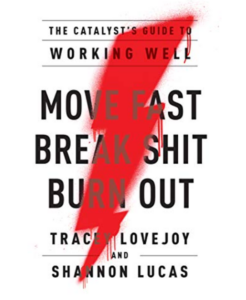Move Fast, Break Shit, Burn Out: The Catalyst’s Guide to Working Well
Tracey Lovejoy and Shannon Lucas
2020, 305 pp, Lioncrest
 As I write this, we’re just a few months into 2021, and, well, the world hasn’t magically changed. When the clocks ticked over on December 31, it felt as if there was a collective, cautious sigh of relief while we continued to hold space for the grief and turmoil so many of us have experienced in the last year. Instead, we’re still in a sort of stasis globally, waiting for vaccine numbers to reach critical mass and learning how to combat new virus variants, so you’d be excused in feeling like this stasis is the new normal.
As I write this, we’re just a few months into 2021, and, well, the world hasn’t magically changed. When the clocks ticked over on December 31, it felt as if there was a collective, cautious sigh of relief while we continued to hold space for the grief and turmoil so many of us have experienced in the last year. Instead, we’re still in a sort of stasis globally, waiting for vaccine numbers to reach critical mass and learning how to combat new virus variants, so you’d be excused in feeling like this stasis is the new normal.
Yet the days are getting longer and on my walks I see the snowdrops pushing their way up through the ground. It feels a little corny to write this, but spring is coming. It has been a long, upending year that’s left me on the edge of burnout (fully over the edge of burnout some days if I’m completely honest) and even more impatient to be able to move forward at my regular speed.
Reading and reviewing Move Fast, Break Shit, Burn Out: The Catalyst’s Guide to Working Well by Tracey Lovejoy and Shannon Lucas for EPIC came at a propitious time for me. I want to navigate 2021 and whatever it brings with an equal or higher level of professional success than I somehow managed last year, but do it in a way that doesn’t leave me feeling like an emptied-out bottle of hand sanitizer. Frankly, anything that helps me to feel more resilient personally and professionally after what 2020 brought us is welcome at this point.
Lovejoy and Lucas detail methods that will help anyone become more resilient and self-aware in the face of change and pressure. Yet the book is specifically written for and about Catalysts. Full disclosure, I took Tracey’s EPIC course, Maximizing Your Impact as a Change Agent, last year and it introduced me to the concept and helped me to identify as a Catalyst myself. So I walked into this review knowing this book would be for me.
So how do you know if you’re a Catalyst, or if that co-worker or manager who you admire and find aggravating in equal measure is a Catalyst? If you’ve been told you move too fast, press too hard, go too far, leave people behind, all the while wondering deep inside you why people just can’t see the path that you see, you might be a Catalyst. The book, and the development of the very idea of a Catalyst, is steeped in robust research with people from all over the spectrum of life and professional experiences, something EPIC members will appreciate. This is not a self-improvement or professional development book built around surface-level observations or just the authors’ own experiences. It is clear that the concept and the work has been deeply researched and iterated on, and I expect the authors will continue to build and iterate as more Catalysts read the book and connect with the authors and other Catalysts.
So how exactly do the authors define a Catalyst? At the core, Catalysts have four defining attributes:
- Subconscious data collection & analysis—Catalysts absorb and process information at lightning speed, taking in information from diverse sources like conversations, research, subconscious observation and more; and then process and synthesize it all, sometimes without even realizing we’re doing so.
- See constant possibility and clear visions to make those possibilities real—Catalysts’ way of being in the world includes a sense of always looking for ways to improve the world or do things in a new way.
- An inherent drive toward action—Catalysts aren’t built to sit back and let the changes we see for improvement go undone. Not manifesting change is painful for Catalysts.
- An experimentation mindset—because Catalysts are constantly taking in information and lean strongly towards forward momentum, we’re open to iteration, in fact it’s another way we’re built, so we’re always taking in more data and incorporating it and integrating it into next steps forward.
While these can be enormous strengths when driving for change, they can also cause real challenges with others who don’t approach the world the same way, naturally causing friction. The Catalyst is taking in everything around them, coming up with a plan, and starting to act on that plan before others have had a chance to fully think about the information and context. This friction and gaps in understanding with those around us, paired with our tendency to keep iterating and need to constantly improve, can be emotionally and energetically draining.
All of this leads to burnout.
One of the things Lovejoy and Lucas do well is help Catalysts understand those gaps between how Catalysts work and experience the world and the way others work, in order to bridge those gaps and work better together. The primary focus of the book, though, is teaching methods for rejuvenation to help Catalysts make their visions reality while managing the effects of burnout. Things like mindfulness, self-awareness and self-compassion, and empathy aren’t in themselves revolutionary, and feel familiar when it comes to self-improvement books. But the authors make a strong case for why these and other rejuvenation practices are essential for Catalysts to keep operating successfully in the world. The book can sometimes feel repetitive; however, that repetition does serve the purpose of hammering home the points the authors are trying to make, making sure their Catalyst readers have absorbed the information before moving on to the next topic in the book. After all, research also shows that repetition is key to catalyzing action, including in ourselves!
Where the book really stands out, though, is not in the methods per se but in the authors’ approach to burnout. In the case of Catalysts, this means accepting the inevitability of burnout. Burnout is just a natural part of being a Catalyst, as much a part of us as that subconscious, lightening-speed absorption of information or the need to constantly seek out better solutions.
The authors don’t offer a magical cure or promise that by following their advice you’ll never burnout again. Where this book really differs is in the fact that it doesn’t offer to take away or “fix” what often feels like a negative result of how Catalysts operate in the world, but instead shows the importance of accepting burnout as a natural result of honoring your Catalyst nature and fully expressing it. Change comes from accepting that inevitability, because knowing you will burnout allows you to focus on mitigation to make it shorter and more manageable. Integrating rejuvenation practices as a natural, non-negotiable part of our way of being in the world, and accepting that we will burnout, allows Catalysts to be prepared and plan for it, making it easier to recover and come back strong and ready to make our next vision a reality.
This book may not be for everyone, but it truly is a love letter of sorts for Catalysts. If you think you might be a Catalyst, guess what, you probably are. And this book is made for you.
More Book Reviews
Making Productivity Social Again: Melissa Gregg’s Counterproductive—Time Management in the Knowledge Economy, reviewed by Raymond June
Ethnographic Thinking: From Method to Mindset, reviewed by David Rubeli
The Power of Not Thinking, reviewed by Gerald Lombardi


0 Comments